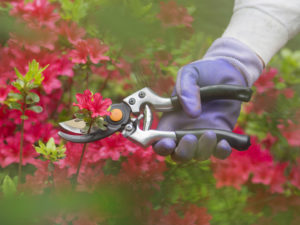In the Garden Blog
Cincinnati's Garden Blog "In the Garden"
Ultimate Fall Gardening Tips for Cincinnati: Your Guide to a Thriving Autumn Garden
Autumn in Cincinnati is a vibrant time for gardening, and it’s the perfect season to prepare your garden for a healthy winter and a beautiful spring. Follow these essential fall gardening tips to keep your garden looking fantastic year-round.
1. Focus on Soil Health 
Healthy soil is the foundation of a successful garden, especially during the fall season. Here’s how to take care of your dirt:
- Till Your Garden Beds: Tilling in the fall allows the soil to freeze and thaw, helping to break up heavy clay. Before you till, add a layer of compost, pine soil conditioner, manure, or finely shredded leaves and grass clippings.
- Amend Your Soil: Fall is the ideal time to add soil amendments like lime, sulfur, or organic matter to improve soil structure. Get a soil test to identify any necessary adjustments.
- Maintain Moisture: Ensure your trees, shrubs, perennials, and newly planted plants have adequate moisture before winter. Proper watering helps plants survive harsh winter conditions. For more details, check out our Watering Guide.
2. Fall Planting: Best Time for Trees, Shrubs, and Bulbs
Fall is the best season for planting many types of plants in Cincinnati.
- Plant Trees and Shrubs: October and November are perfect for planting most trees, shrubs, evergreens, and perennials.
- Spring Bulbs: Now is the time to plant spring-flowering bulbs like tulips, daffodils, crocuses, hyacinths, and alliums. For a splash of color indoors, plant bulbs in pots for early spring blooms.
- Summer Bulb Care: Dig up summer bulbs such as cannas, gladiolas, and caladiums after the first light frost. Store them in a cool, dark place until spring.
- Indoor Bulbs for Winter Blooms: Plant amaryllis and paperwhite bulbs now for stunning winter flowers. Stagger the planting times for continuous blooms throughout the season.
- Herbs for Indoor Growing: Pot up herbs like basil, mint, and parsley to enjoy fresh flavors indoors over the winter months.
- Transplant and Divide Perennials: Fall is the ideal time to transplant trees and shrubs or divide spring-flowering perennials like peonies and irises.
3. Fall Garden Clean-Up
Cleaning up your garden in the fall sets the stage for a healthy spring garden.
- Remove Dead Foliage: Cut back dead foliage from perennials and remove spent annuals. Leave the roots in the ground to decompose and enrich the soil.
- Compost Disease-Free Debris: Add healthy plant debris to your compost pile. Avoid composting diseased plants to prevent spreading issues next year.
- Clean Around Fruiting Trees: Remove fallen fruits, diseased leaves, and branches to reduce pest and disease problems next season.
4. Protect Your Plants
Fall is the time to prepare your plants for winter survival.
- Apply Pre-Emergent Herbicide: Use a pre-emergent herbicide in your landscape beds to prevent winter annuals like chickweed and henbit from germinating.
- Deer Protection: Protect young trees and deer-susceptible plants with trunk guards or deer repellents like DeerScram or Liquid Fence.
- Winterize Evergreens: Keep your evergreens watered throughout the fall, and consider applying an anti-desiccant spray like WiltStop for added protection.
- Spray Delicate Plants: Treat rose canes and Japanese maples with a protective spray to guard against winter damage.
5. Pruning in Fall: Do’s and Don’ts
Pruning can help shape your plants, but timing is crucial.
- Light Pruning Only: Focus on minor hand-trimming of evergreens and tree limbs. Avoid heavy pruning, as it can harm the plants. Save major pruning for late winter or early spring.
- Wait to Prune Roses: Hold off on pruning roses until they go dormant and the soil is near freezing. This helps protect the plant during the winter months.
6. Weed Control
Fall is the most effective time to tackle broadleaf weeds.
- Apply Weed Killer: As weeds prepare for winter, they draw nutrients (and herbicides) into their roots, making fall the optimal time for weed control. Spot-treat problem areas and be cautious if you have newly seeded grass—ensure it has been mowed at least three times before applying any weed killer.
7. Feed and Mulch Your Garden
Prepare your garden for winter dormancy with proper feeding and mulching.
- Feed Trees and Shrubs: Consider late fall feeding for trees. Use methods like vertical mulching or a soil injection with a Ross Root Feeder. For evergreens, feed at half the usual rate or wait until spring.
- Mulch Wisely: Wait until the ground is consistently cold (below 40°F) before applying winter mulch. Keep mulch away from the base of trees and shrubs to prevent rot and pest problems.
8. Bring Plants Indoors
Don’t forget your tropical plants and potted favorites!
- Acclimate Indoor Plants: Before night temperatures drop below 50°F, move your tropical plants indoors. Gradually acclimate them by placing them in a shaded area for about 10 days.
- Overwintering Potted Plants: Move dormant plants to an unheated garage or shed. Keep them cool and water lightly once a month to prevent them from drying out.
Need More Help with Your Cincinnati Fall Garden?
Our expert horticulturists are here to answer your questions and provide personalized advice. Visit us today for all your gardening needs, from soil amendments to plant protection products.
Happy Fall Gardening, Cincinnati! Let’s make this season the best yet for your garden.
Stop by and visit Natorp’s Plant Expert or Email Us!
#CincinnatiGardeningTips#FallGardenPrep#OhioFallGardening#PlantingInCincinnati#AutumnGardenGuide